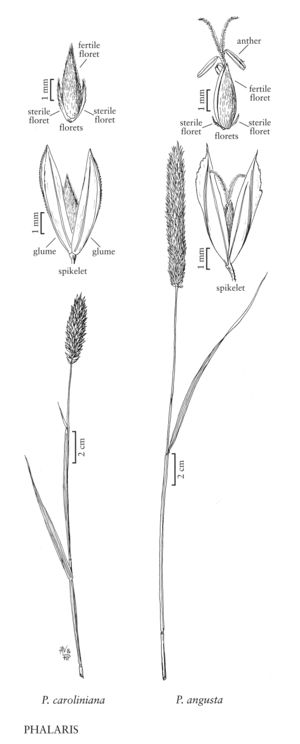Phalaris angusta
Plants annual. Culms 10-170 cm. Ligules 4-7 mm, truncate to rounded or obtuse, lacerate; blades 3-15 cm long, 2-12 mm wide. Panicles 2-20 cm long, 0.6-1.5 cm wide, cylindrical, discontinuous, sometimes lobed; branches sometimes evident, spikelets borne singly, not clustered. Spikelets homogamous, with 3 florets, terminal floret bisexual; disarticulation above the glumes, beneath the sterile florets. Glumes 2-6 mm long, 0.6-1.1 mm wide, rectangular, often purplish, keels winged, scabrous, wings about 0.4 mm wide, smooth, lateral-veins conspicuous, scabrous, apices mucronate; sterile florets 2, equal, 0.5-1.5 mm, linear, sparsely and inconspicuously hairy; bisexual florets 2-3.8 mm long, 0.9-1.5 mm wide, laterally compressed, hairy, particularly distally, shiny, apices tapering; anthers 0.5-1.3 mm. 2n = 14.
Distribution
Miss., Tex., La., Calif., Ala., Ga., S.C., Ariz., Fla., Oreg., N.Mex.
Discussion
Phalaris angusta grows in the contiguous United States, primarily in the south. In South America, it is most abundant in a band from Chile to Argentina; it also grows in Ecuador, Peru, and Bolivia. Thellung (1911) considered it to be a South American species that is adventive in North America. Throughout its distribution, it tends to grow in open grasslands and prairies.
Baldini (1995) suggested that Phalaris angusta, P. lemmonii, and P. caroliniana are involved in reciprocal hybridization and introgression, particularly in California.
Selected References
None.
Lower Taxa
"decumbent" is not a number.
